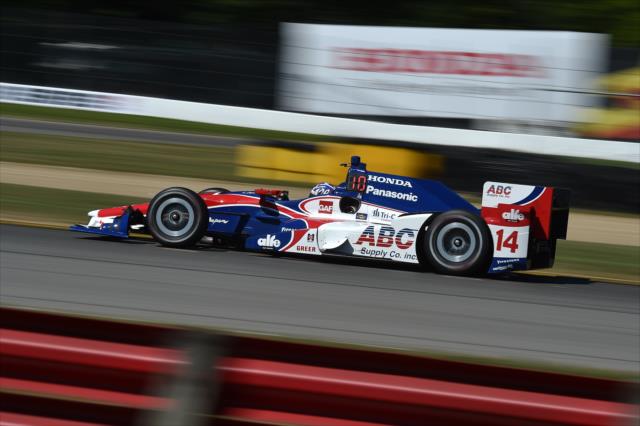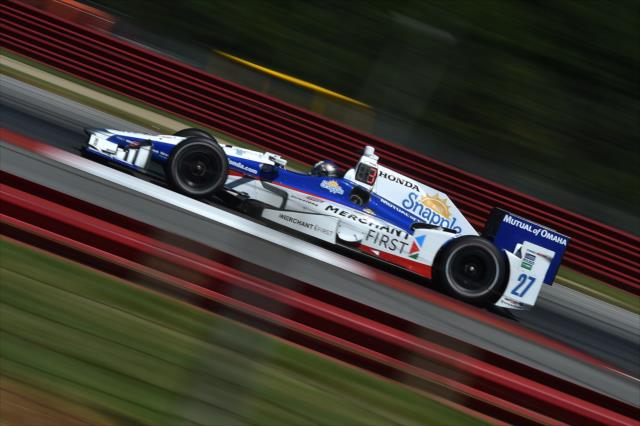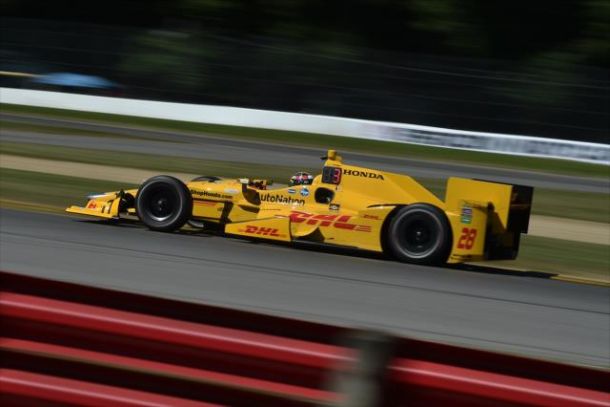They were first tested in April at Barber Motorsports Park.
They were set to debut at the 99th Running of the Indianapolis 500.
Here were are, in the third-to-last race of the 2015 Verizon IndyCar Series season, and the LED position panels are fitted to the side of each car in the field - ready to take the green flag for a 90-lap race at the Mid-Ohio Sports Car Course.
So far this weekend, they've been flawless and much enjoyed by the fans along the 2.258-mile permanent road course.
For a quick explanation and demonstration of this impressive new technology:
Now, let's go a bit more in depth on reviewing the weekend so far with the technology and what to expect from them in Sunday's race.
Bright Sun vs. LED Panels
In their use in the three practice sessions and qualifying that precede Sunday's race, the Light Emitting Diode (LED) panels kept fans, commentators, and even TV viewers in the know of who was where on the timesheet in live time.
Through perfect weather on the opening two days of the weekend, it was questioned how the new technology would fair in bright sunlight. They've risen to the challenge and have proven to be very visible as the cars go by. At times, the intensity of the sun does make them a bit more dim, and the color of the cars cause visibility of the panels to fluctuate as well (note Ryan Hunter-Reay's bright yellow car, pictured above).
"Even with all the sunlight, it’s easy to see them,” said Lance Fulks, a race fan who has visited the Mid-Ohio Sports Car Course for this race a dozen times, per an interview with IndyCar.

Whether you were at the track or watching on Friday and Sunday to see the first few sessions with the new technology in use, you had no problem seeing the LED panels on display (no pun intended), keeping you up-to-the-second in the know as to who was running where on the timesheet during the session. It's a great thing, to be in the know when you're at the race track; INDYCAR has done well with these is the general takeaway following three practice sessions and qualifying for Sunday's race.
What Is Brought To The Table?
If you paid a bit of attention during any of the practice sessions or qualifying on Friday and Saturday, then you're likely almost an expert on what the panels look like and what they do - that's how easy they are to understand.
Basically, they have three 'modes', if you will:

The main 'mode', of course, shows the current position of the car in red. This, during practice/qualifying sessions, is updated when the car crosses the start/finish line; during Sunday's race, the position shown on the panel for each car will be updated when they cross various INDYCAR Timing and Scoring markers along the track - something that isn't done in other series that utilize a similar technology.
Also, the panels will switch from the position in red to a flashing PP when the driver engages the push to pass horsepower boost. This will be interesting to see in use during the race.
Lastly, when a driver steers into their pit box, the panel will switch to a green stopwatch to time their pit stop. As drivers came back in following installation laps during the sessions thus far this weekend, this was the part of the panels that surprised most; the fluid switch from the position to the counting clock is impressive, and it simply works perfectly - as it should. This feature really stunned, and is sure to catch the eye of more viewers on TV and at the track on race day.
These three features were of course explained in the video above, but it is noteworthy that, other than the push to pass symbol of course (not in use during practice/qualifying), they were depicted very well during the sessions completed thus far this weekend.
What To Expect From 'Em During The Race
Their simplicity is remarkable and was truly put on display (again, not intended) for those watching the early sessions this weekend to get an early glimpse of a technology that is ahead of its time in the world of motorsports. In the race, many more will be watching the LED panels make their race-day debut - and they are bound to be impressed with what they see.
Expect them to work perfectly at serving their main purpose: displaying the current position of each car on track. And with the position being updated at various spots around the track, passes will be accounted for more than once every lap. Hopefully this is stressed on TV so even the most casual of fans can't help but wow at what is brought to the table by the LED position panels.

Something to definitely be excited to watch for during the race is what is shown on the panels when a group of cars is racing off pit lane, trying to gain positions with a quick stop. During the stop, of course, the stopwatch engages and begins counting the duration of the service in green. When the driver exits their pit box and heads toward pit-exit, the green remains shown, allowing fans to compare the length of pit stops for various cars as they rush back onto the course.
Being closer to pit stops, being more involved throughout the entire race and up to date with who is where - this technology allows for it.
It's vital, it belongs in a series as premier as the Verizon IndyCar Series, and hopefully fans are enlightened during Sunday's 90-lap event at Mid-Ohio.
Follow @VAVELIndyCar on Twitter for live tweeting during the Honda Indy 200 on Sunday, and tweet us your thoughts on the debut of this new technology using the hashtag #VAVELIndyCar.
Aaron Durant is the editor of the VAVEL USA Racing section. Follow him on Twitter at @DoubleA291.









































